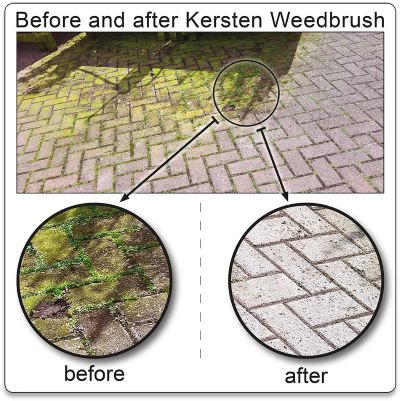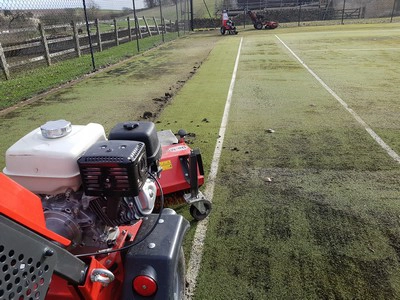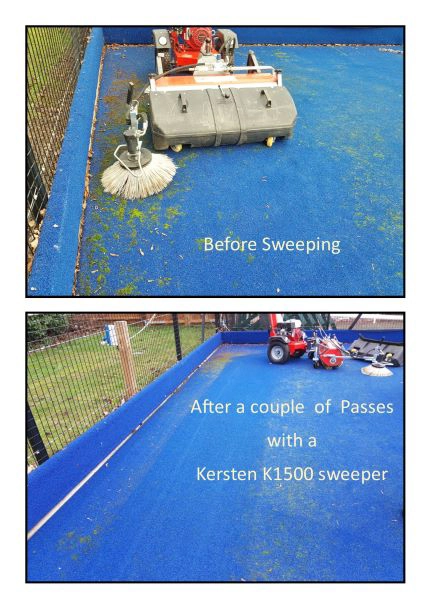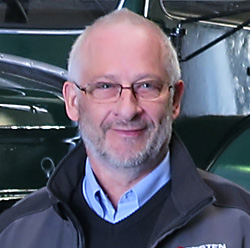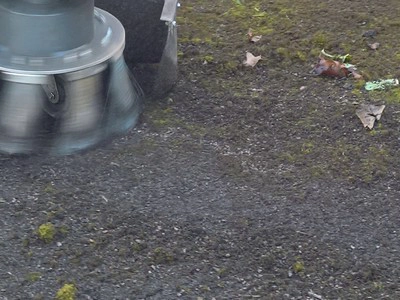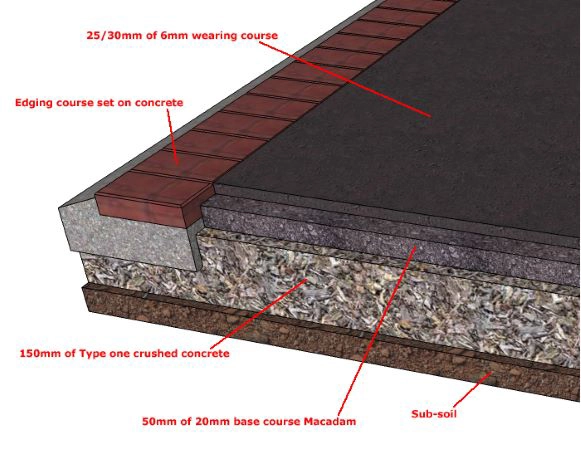Moss and Algae Management
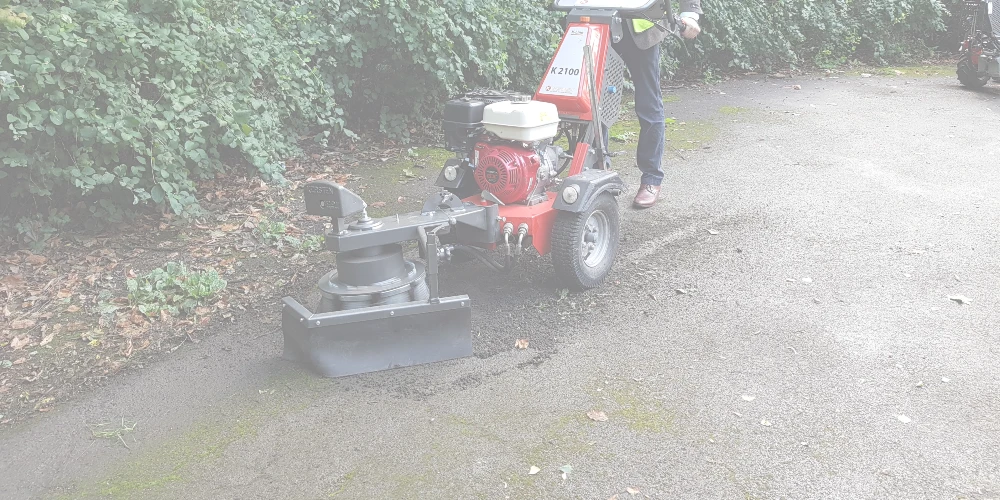
Moss and Algae Management
Preventing Moss and Algae Growth on Hard Surfaces
Moss and algae thrive on hard and artificial surfaces when detritus decomposes, creating a nutrient-rich environment. Factors like moisture, poor drainage, and shady areas provide ideal conditions for moss and algae growth, particularly along kerb edges, shaded pathways, and poorly drained surfaces. If left unchecked, moss and algae can damage hard surfaces such as tarmac, asphalt, and block paving, making them slippery and hazardous. Regular moss and algae management is crucial to maintaining surface integrity and safety.
Effective Moss and Algae Management Across Different Surfaces
To manage moss and algae effectively, regular maintenance is crucial. Start by clearing away decomposing detritus with a sweeper with collector box to prevent nutrient buildup. However, when dealing with wet moss, traditional sweepers might smudge the material rather than removing it effectively.
For more persistent moss and algae growth, a De-Moss brush is a highly effective tool. Its design is optimized for removing moss from hard surfaces, but it may struggle with surfaces that have many holes and cracks, as its bristles can’t always penetrate deeply into these areas.
A weed brush offers a powerful solution for moss removal. Its versatile bristles can tackle almost all moss and algae issues. For more challenging, compacted, or heavy-duty situations, the Hausa brush provides robust performance. While effective, it can be more time-consuming and aggressive compared to other methods.
In addition to using the right tools, improving drainage and reducing shade on surfaces are crucial for preventing future growth. By combining these techniques, you can ensure that hard surfaces, from pavements to artificial sports courts, remain clean, safe, and free from moss and algae.
Articles about moss and algae management
Weeds thrive on tarmac and asphalt surfaces when detritus, such as leaves and twigs, accumulates in gullies and along pavement edges. This buildup creates a medium for weeds to grow. Once weeds establish themselves in the debris, their roots can penetrate the surface, leading to cracks and further surface damage. Over time, the cracks widen, causing the surface to crumble and form potholes. Regular use of a gully brush and powered sweeper with a collector box is essential for clearing debris from edges and gullies, preventing detritus from rotting and providing a breeding ground for weeds. This helps maintain the integrity of the surface and prevents costly damage.
A freeze-thaw cycle refers to the repeated process of water freezing and thawing within the surface cracks of tarmac or asphalt. When water freezes, it expands by about 10%, putting pressure on the surrounding material. This repeated expansion and contraction weaken the tarmac, causing cracks to widen and surface deterioration.
Organic material, such as leaves, soil, and debris, exacerbates freeze-thaw damage. These materials collect in cracks and gullies, trapping moisture. As the moisture freezes, it expands and exerts additional pressure on the tarmac. The decomposition of organic material further contributes to erosion, creating a cycle of damage. To mitigate these effects, regularly use a gully brush and powered sweeper with a collector box to remove organic debris and maintain effective drainage. Timely repairs of cracks and surface damage are also crucial in preventing further deterioration.
Moss growth on concrete surfaces is typically caused by the accumulation of organic material, such as leaves and soil, combined with excess moisture. These conditions create an ideal environment for moss to thrive. Organic material collects in cracks and low-lying areas of the concrete, trapping moisture that facilitates moss growth.
To prevent moss from growing on concrete, follow these steps:
- Regular Sweeping: Use a powered sweeper with a collector box to remove debris and prevent detritus build-up. This reduces moisture retention and eliminates potential growth mediums for moss.
- Gully Brush Maintenance: Employ a gully brush to clean debris from the edges of pavements and in gullies. This ensures that water can drain properly and prevents the accumulation of organic material.
- Proper Drainage: Maintain and clear drainage systems to ensure effective water runoff. Standing water encourages moss growth, so efficient drainage is crucial.
- Cut Back Vegetation: Trim overgrown plants and remove organic debris to minimize moisture retention and reduce shaded areas where moss is likely to grow.
- Regular Inspections and Repairs: Check for and repair any cracks or surface damage that could trap moisture. Timely repairs help maintain the integrity of the concrete and prevent moss from establishing.
By implementing these practices, you can keep your concrete surfaces clean, reduce moss growth, and extend the lifespan of your concrete.
When deciding between a sweeper and a weed brush for asphalt and tarmac maintenance, consider the specific issues you're facing:
- Sweeper: Ideal for removing loose debris, leaves, and dirt that accumulate on the surface and in gullies. A powered sweeper with a collector box is effective in preventing detritus buildup, which can obstruct drainage and lead to moss and weed growth. It is also useful for cleaning edges and keeping pavements clear. Our pedestrian sweepers also come with a de-moss brush, which helps remove moss and algae that may have started to grow on the surface.
- Weed Brush: Best for tackling established weeds and moss that have penetrated the surface. A weed brush can effectively remove these invasive plants, which can cause surface cracks and deterioration over time. It’s particularly useful in areas where weeds have started to penetrate the tarmac, causing damage.
Recommendation: For comprehensive maintenance, use a combination of both tools. Start with a weed brush to address any existing moss and weeds, then follow up with a sweeper to clear the surface and prevent further issues. This dual approach ensures both removal of vegetation and effective debris management, maintaining the integrity and appearance of your asphalt or tarmac surfaces.
Yes, a sweeper can be highly effective for maintaining both hard and artificial surfaces, although the tasks differ slightly.
On Hard Surfaces: Sweepers remove loose debris and moss, preventing moss buildup and allowing the surface to dry out faster, which reduces freeze-thaw damage.
On Artificial Surfaces: Sweepers do all of the above also de-compact infill, redistribute it across the surface, remove moss, and lift the grass pile. This ensures better support for play and maintains a smooth, uniform surface.
For comprehensive maintenance on both surface types, explore our range of Kersten outdoor sweepers, including pedestrian and tractor-mounted models equipped with powerful spiral brushes for effective debris removal.
Without regular grooming, infill redistribution, and damage inspection, artificial surfaces can become compacted due to heavy traffic, leading to drainage problems, flooding, and an uneven, hard surface. These issues significantly decrease playability and surface life.
A regular maintenance routine with tools like the Kersten static brush helps prevent surface compaction, ensuring optimal performance and a longer lifespan for your artificial surface.
Heavy use and environmental factors can lead to matting and compaction over time, which flattens synthetic fibres and compresses the infill. To prevent these issues, regular brushing is essential. Using a powered sweeper over areas of heavy traffic and brushing redistributes the infill and lifts the fibres, helping to restore the surface’s resilience and natural appearance.
Kersten static brush to lift the fibres and redistribute the infill. For larger areas, a drag brush is ideal for maintaining a smooth and durable surface.
Moss and algae can be effectively removed with a sweeper. Regular use helps prevent the buildup of organic material that fosters moss growth. Equipped with a collector box, the sweeper gathers the removed moss and debris, and may also collect some of the infill. This collected infill might need to be topped up to keep your artificial grass in optimal condition.
Discover our sweeper range and the Kersten De-moss Brush here.
To keep your artificial grass in optimal condition, follow these guidelines:
Adjust the Brush Height: Set the brush height to skim just above the surface of the artificial grass. This ensures you clear light debris without disturbing the grass fibers.
Use Appropriate Equipment: For effective cleaning, use a wide area brush for larger areas or a reciprocating brush to remove excess material on natural turf and synthetic surfaces. Alternatively, consider a sweeper with an adjustable brush height.
Establish a Regular Schedule: Implement a consistent sweeping routine to prevent debris buildup and maintain optimal surface conditions.
Surface Displacement refers to the shifting or movement of the artificial grass, causing uneven areas or wrinkles.
How to Treat Surface Displacement:
- Use a Drag Mat or Static Brush: These tools can help redistribute the infill evenly and smooth out the surface.
- Re-secure Edges: Ensure edges and seams are properly secured with adhesives or fasteners.
- Check for Infill: Adjust or add infill as needed to maintain an even surface.
For significant issues, consider consulting a professional to ensure proper repair and maintenance.
Yes, Kersten static brushes are versatile and can be used on various surfaces such as artificial sports fields, playgrounds, and indoor turf installations. They effectively remove debris and maintain surface cleanliness across different applications.
